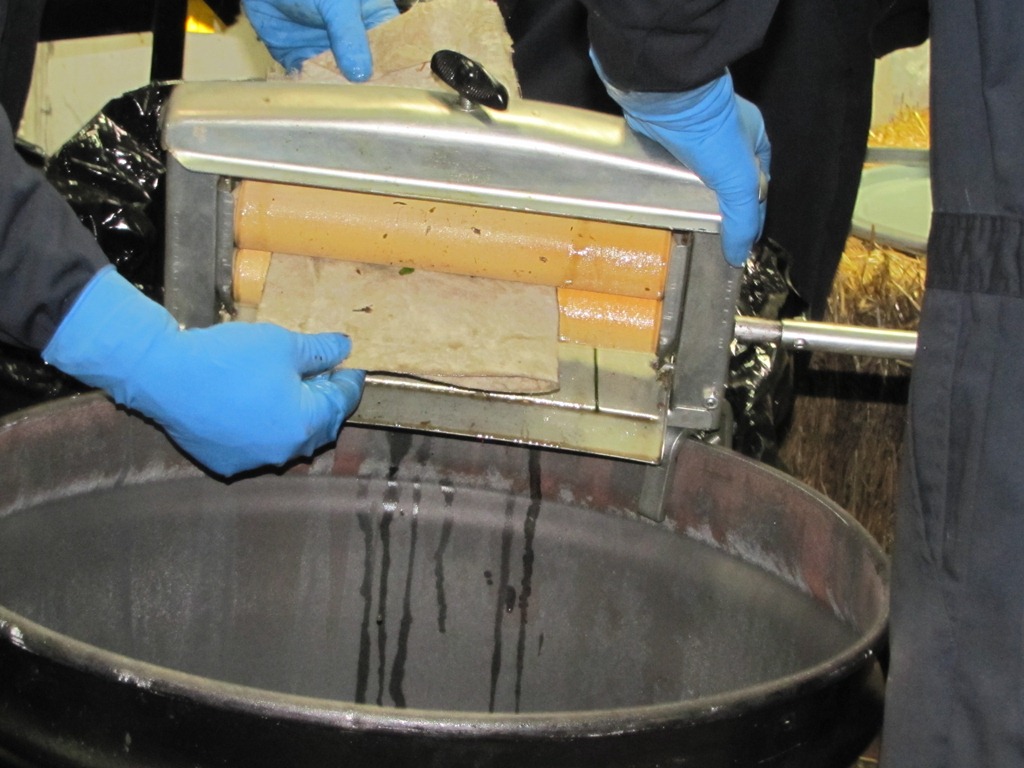Ship overboard discharge spill
Naval Base Kitsap Bangor experienced a spill from a waste-transfer system located on a pier into Hood Canal.
Summary information
Naval Base Kitsap Bangor, Hood Canal, WA

Responders working at the site of the spill use absorbent pads to measure how much oil is recovered.
Status updates
February 13, 2014
Monday afternoon, February 10, Naval Base Kitsap Bangor, a part of the U.S. Naval installation in west Puget Sound experienced a spill from a waste-transfer system located on a pier into Hood Canal.
As part of the transfer system, a tank exists on the pier and accepts oily waste (water, hydraulic fluid, transmission fluid, lubricants, etc.) from ships. Monday, the tank system malfunctioned and overflowed. The Navy immediately began responding. They deployed 4000 feet of oil containment boom around the affected area and notified the Department of Ecology (Ecology) and the National Response Center/U.S. Coast Guard. Early estimations of the spill were 150 gallons.
Early Tuesday, after further investigation and an aerial overflight by the U.S. Coast Guard a large sheen was observed on the water outside of the containment area. The Navy — along with its partners at the Coast Guard, Ecology and the Department of Fish and Wildlife (DFW) — established a Unified Command Center at Bangor. The spill was reassessed to be up to 2,000 gallons of oily waste.
Wednesday the cleanup continued and the Unified Command held a press conference at Salisbury Point Park, located near the Hood Canal Bridge. Seattle (KOMO) and local media attended.
Thursday morning another overflight was conducted to view the status of the sheen in the canal. Aerial observations showed the sheen in the canal dissipating. Ecology will continue to monitor until there is no threat of harm to wildlife or the environment. Cleanup efforts are focused on the Delta Pier where the product is recoverable.
Cleanup efforts are ongoing and include containing and skimming as much product from the water as possible; implementing local geographic response plans (which include booming naturally sensitive areas at Lofall, Devil’s Hole and Thorndyke Bay); and assessing shorelines.
No harmful effects to beaches, wildlife or marine life have been identified or reported.
The cleanup/recovery process is expected to continue over the next few days. Once complete, Ecology will begin to analyze data and provide information regarding how much product was recovered and its level of toxicity. Tuesday the Department of Health (DOH) issued a ‘precautionary recommendation’ to avoid harvesting or eating shellfish from Bangor north to the Hood Canal Bridge. Once DOH receives sample results from Ecology, they can reassess their recommendation.
Members of the public or community are urged to call 1-800-22-BIRDS if they notice oiled wildlife or beaches.
Media contact
Tom Danaher, U.S. Navy
Public Affairs Officer,
Naval Base Kitsap
(360) 627-4031/4030

